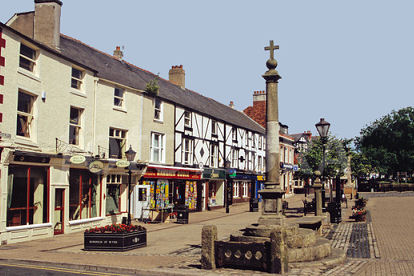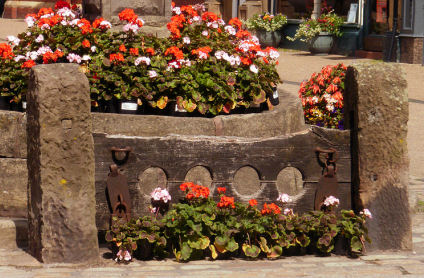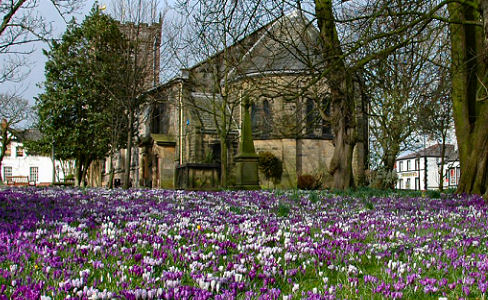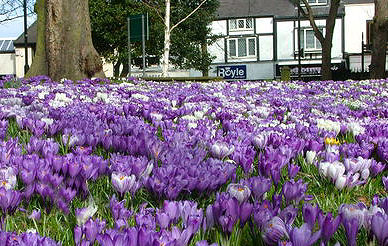Poulton-le-Fylde
OS Grid ref:- SD3439
 The historic market town of Poulton-le-Fylde, is situated 5 miles (8 km) to the north-east of Blackpool. With its charming cobbled streets, boasts much character and has something for everyone, the town centre has been a Conservation Area since 1979 and 15 buildings and structures in the town have been designated as listed buildings by English Heritage.
The historic market town of Poulton-le-Fylde, is situated 5 miles (8 km) to the north-east of Blackpool. With its charming cobbled streets, boasts much character and has something for everyone, the town centre has been a Conservation Area since 1979 and 15 buildings and structures in the town have been designated as listed buildings by English Heritage.
The market place at the centre of Poulton-le-Fylde, is the width of two streets, lying to the south of the ancient St Chad's Church and surrounded by shops, the square contains the town's war memorial as well as a market cross, stocks, whipping post and fish slabs, from which fish were sold on market days. Records reveal that a market has been held in Market Square since at least 1348. Up until the nineteenth century there were wooden stocks in the square. Here wrong doers were locked in and had rotten food and eggs thrown at them. The original stocks still stand there. Although many of the buildings surrounding the market place were rebuilt following a fire in the eighteenth century, a few of the earlier buildings survive. To the south of the market place are town houses that were built for local merchants.
 The Golden Ball pub, which probably dates from the eighteenth century, was also the meeting place of the local court, and at the end of the nineteenth century, the town's cattle market was moved behind the pub from the market place. The Thatched House pub existed at least as early as 1793 and may have been built in the Middle Ages. The pub was rebuilt in 1910 in the Mock Tudor style and has been identified as one of the town's "key landmarks" by the Poulton Market Town Initiative.
The Golden Ball pub, which probably dates from the eighteenth century, was also the meeting place of the local court, and at the end of the nineteenth century, the town's cattle market was moved behind the pub from the market place. The Thatched House pub existed at least as early as 1793 and may have been built in the Middle Ages. The pub was rebuilt in 1910 in the Mock Tudor style and has been identified as one of the town's "key landmarks" by the Poulton Market Town Initiative.
The three-mile long Poulton-le-Fylde Historic Trail, starts at the River Wyre Hotel, a nineteenth century public house close to Skippool Creek, where smuggling was once rife. From here the trail wanders past salad-growing fields and quaint cottages to arrive at St Chad’s Church.
The town has an ancient history, evidence of human habitation exists in the area around Poulton from c. 10,000 BC. In 1970 during building work in nearby Carleton the 12,000 year-old skeleton of an elk was uncovered, along with two bone or antler barbed points close to its hind bones. In the first century AD, the area was inhabited by a Celtic tribe called the Setantii. 400 Roman coins, dating to the fourth century has also been uncovered in the area, near Fleetwood
Local place names incorporate Anglo-Saxon elements like tun (farmstead), suggesting that their founding took place in that period. Poulton was recorded in 1086 as Poltun; the name derives from the Anglo-Saxon words pull or pol + tun meaning "farmstead by a pool or creek". The affix le-Fylde was added in 1842 to distinguish the town from Poulton-le-Sands, a village which has now become part of the town of Morecambe. The dedication of Poulton's parish church to the seventh century Anglo-Saxon saint Chad of Mercia lends weight to its pre-conquest foundation, although it is possible that it was built between 1086 and 1094.
Poulton is one of seven ancient parishes forming the hundred of Amounderness. Prior to the Norman conquest of England in 1066, Amounderness was owned by Earl Tostig, the brother of King Harold II, who was killed at the Battle of Stamford Bridge. Between 1069 and 1086, William the Conqueror granted Amounderness to the Norman baron Roger the Poitevin, Roger was eventually banished from the country and his lands returned to the possession of the Crown. In 1194 King Richard I 'the Lionheart' granted the hundred of Amounderness to Theobald Walter, 1st Baron Butler, who held it until his death in 1206. In 1268, King Henry III granted the wapentake of Amounderness to his son Edmund Crouchback, who became the 1st Earl of Lancaster around this time.
St Chad's Church
 The earliest records of St. Chad's church date back to 1094, although the tower dates from the 1630s (possibly during the reign of Charles I) and the main body of the church was constructed in 1752 .
The earliest records of St. Chad's church date back to 1094, although the tower dates from the 1630s (possibly during the reign of Charles I) and the main body of the church was constructed in 1752 .
The church, which stands at the centre of the town, was extensively renovated in 1751. It was previously thought that the old church (except the tower) was completely demolished but recent evidence indicates that the "new" building still contains the outer walls of the previous ancient structure. A round Norman-style apse was added to the church in 1868, the architects being the famous Lancaster partnership of Paley and Austin.
The ceiling of the building has shallow ribbed vaulting and there are galleries to the north, west and south, accessed by a Georgian staircase with turned balusters. The north and south galleries are supported by plain Tuscan columns and both contain box pews that date from 1752.
 Stained glass dates from the late nineteenth century to the mid twentieth century and includes work by Lancaster designers Shrigley and Hunt. The Jacobean style pulpit was constructed in 1955 from the four sides of a seventeenth century pulpit. It has arabesques and a portion of an inscription from the Book of Isaiah.
Stained glass dates from the late nineteenth century to the mid twentieth century and includes work by Lancaster designers Shrigley and Hunt. The Jacobean style pulpit was constructed in 1955 from the four sides of a seventeenth century pulpit. It has arabesques and a portion of an inscription from the Book of Isaiah.
In the south-west corner of the nave is a choir vestry, which was originally built as a baptistery. Its screen is made of carved oak, formed in 1883 from one part of the Fleetwood family box pew that was originally situated in the chancel where the choir stalls are now situated. In 1883, this pew had been described as "looking like a cross between a railway carriage and the centre piece of a gondola". The wood is carved with emblems of the family including a double-headed eagle, wheat sheaves and a griffin. The screen door comes from the box pew of another prominent local family—the Rigbys of Layton.It has a carving of a goat's head and is inscribed with "AR 1636". Six hatchments hang in St Chad's in memory of eighteenth century members of the Hesketh-Fleetwood family. These hatchments are diamond-shaped representations of individual coats of arms, painted for their funeral processions and then hung in the parish church.
To the south of the church there are the remnants of a stone preaching cross. In springtime the churchyard is covered by a colourful carpet of purple, yellow and white crocus.
Nearby Places of Interest
Cleveleys coastal resort, famous for its miles of golden beaches.
Pilling charming coastal village
Blackpool Tower - first opened to the public on 14 May 1894. Inspired and modelled on the Eiffel Tower in Paris, the tower soars to 518 feet 9 inches (158.12 metres) high above Blackpool’s famous Golden Mile.
The Sea Life Centre, Blackpool, billed as a "friendly and authoritative guide to the last great frontier...the seas and oceans of the world and their myriad mysterious and amazing inhabitants." The centre is home to one of the largest collections of tropical sharks in Europe.
Blackpool Model Vilage and Gardens an award winning visitor attraction, established in 1972, is set in a stunningly beautiful landscaped 2½ acres of carefully tended gardens with paved pathways that provide full access to visitors.
